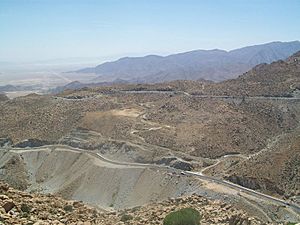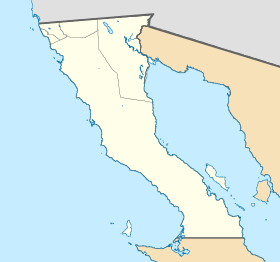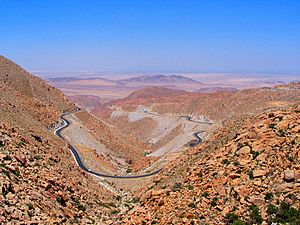La Rumorosa facts for kids
Quick facts for kids
La Rumorosa
|
|
|---|---|
 |
|
| Country | |
| State | |
| Municipality | Tecate |
| Elevation | 4,192 ft (1,278 m) |
| Population
(2010)
|
|
| • Total | 1,836 |
| Time zone | UTC−8 (PST) |
| • Summer (DST) | UTC−7 (PDT) |
| Area code(s) | 686 |
La Rumorosa is a town in Baja California, Mexico. It is part of the municipality of Tecate. About 1,800 people live there.
The town is located on the main road between Mexicali and Tecate. It is also very close to the international border with Jacumba Hot Springs, California in the United States. However, there is no official border crossing in La Rumorosa itself. The closest one is in Tecate. Many people visit La Rumorosa to see ancient Native American cave paintings.
Contents
Location and Altitude
La Rumorosa is high up in the mountains. It sits about 1,278 meters (4,192 feet) above sea level. This high altitude gives it a special climate.
The Famous La Rumorosa Road
"La Rumorosa" also refers to a very famous road. This road crosses the Sierra de Juárez Mountains in Baja California. It is part of Mexican Federal Highway 2D. The road was finished in 1917. Before this road was built, people traveling between Tijuana and other parts of Mexico had to go through the United States.
When it was first built, the road was a two-way street. It was quite dangerous because of strong winds and steep slopes. Some drivers also drove too fast, causing many accidents. Today, the road has been improved. There are now two separate two-lane roads, one for going up and one for going down. This has made it much safer.
Even with these safety improvements, the road is still considered challenging for new drivers. It is always a good idea to keep a safe distance from other cars. Drivers should also follow the speed limit and use engine braking when going downhill. Using headlights is also smart when the weather is bad.
Ancient Cave Paintings at El Vallecito
In La Rumorosa, you can find an important archaeological site called "El Vallecito". This site has a collection of ancient Native American paintings. These paintings show us a lot about the history and culture of the people who lived in Baja California long ago.
Besides the paintings, you can also find pieces of pottery and many stone mortars at the site. So far, more than 18 groups of paintings have been found at El Vallecito. Some of the most important ones include:
- The "Rooted Man" group
- The "Indian Cave"
- The "Imp" group
- The "Wittinñur" group
- "The Shark"
Climate and Weather
Because La Rumorosa is high up, it has a cool, semi-arid climate. This means it's mostly dry but not as hot as a desert.
In winter, it can get very cold. There can even be a lot of snow, especially in January. In summer, the area sometimes gets thunderstorms. These are known as monsoons. Winter can also bring snowstorms.
The average temperature in January, the coldest month, is about 7.3°C (45.1°F). In July, the hottest month, the average temperature is about 25.3°C (77.5°F). La Rumorosa also has strong winds. These winds are good for making wind power.
| Month | Jan | Feb | Mar | Apr | May | Jun | Jul | Aug | Sep | Oct | Nov | Dec | Year |
|---|---|---|---|---|---|---|---|---|---|---|---|---|---|
| Record high °C (°F) | 27.0 (80.6) |
28.0 (82.4) |
31.0 (87.8) |
33.0 (91.4) |
38.0 (100.4) |
45.0 (113.0) |
42.0 (107.6) |
40.0 (104.0) |
40.0 (104.0) |
39.0 (102.2) |
35.0 (95.0) |
30.0 (86.0) |
45.0 (113.0) |
| Mean daily maximum °C (°F) | 12.8 (55.0) |
13.5 (56.3) |
15.5 (59.9) |
19.0 (66.2) |
23.1 (73.6) |
28.9 (84.0) |
32.5 (90.5) |
31.7 (89.1) |
28.4 (83.1) |
22.9 (73.2) |
17.1 (62.8) |
13.6 (56.5) |
21.6 (70.9) |
| Daily mean °C (°F) | 7.3 (45.1) |
7.9 (46.2) |
9.5 (49.1) |
12.2 (54.0) |
15.8 (60.4) |
21.2 (70.2) |
25.3 (77.5) |
24.7 (76.5) |
21.5 (70.7) |
16.3 (61.3) |
11.1 (52.0) |
7.9 (46.2) |
15.1 (59.2) |
| Mean daily minimum °C (°F) | 1.9 (35.4) |
2.4 (36.3) |
3.4 (38.1) |
5.4 (41.7) |
8.5 (47.3) |
13.5 (56.3) |
18.1 (64.6) |
17.8 (64.0) |
14.5 (58.1) |
9.7 (49.5) |
5.1 (41.2) |
2.2 (36.0) |
8.5 (47.3) |
| Record low °C (°F) | −20.0 (−4.0) |
−18.0 (−0.4) |
−9.0 (15.8) |
−5.0 (23.0) |
−3.0 (26.6) |
1.0 (33.8) |
4.0 (39.2) |
6.0 (42.8) |
0.0 (32.0) |
−4.0 (24.8) |
−18.0 (−0.4) |
−12.0 (10.4) |
−20.0 (−4.0) |
| Average precipitation mm (inches) | 24.8 (0.98) |
17.7 (0.70) |
20.7 (0.81) |
10.3 (0.41) |
2.0 (0.08) |
0.8 (0.03) |
9.6 (0.38) |
12.8 (0.50) |
8.8 (0.35) |
12.8 (0.50) |
15.1 (0.59) |
20.6 (0.81) |
156.0 (6.14) |
| Average precipitation days (≥ 0.1 mm) | 3.3 | 2.7 | 2.8 | 1.5 | 0.4 | 0.2 | 1.0 | 1.4 | 1.0 | 1.1 | 1.7 | 2.4 | 19.5 |
| Source: Servicio Meteorologico Nacional | |||||||||||||
See Also
 In Spanish: La Rumorosa para niños
In Spanish: La Rumorosa para niños




